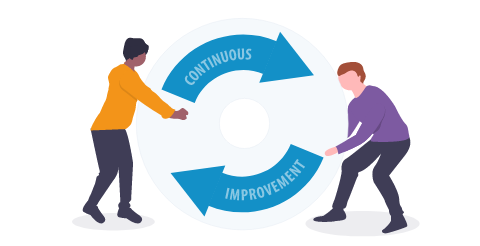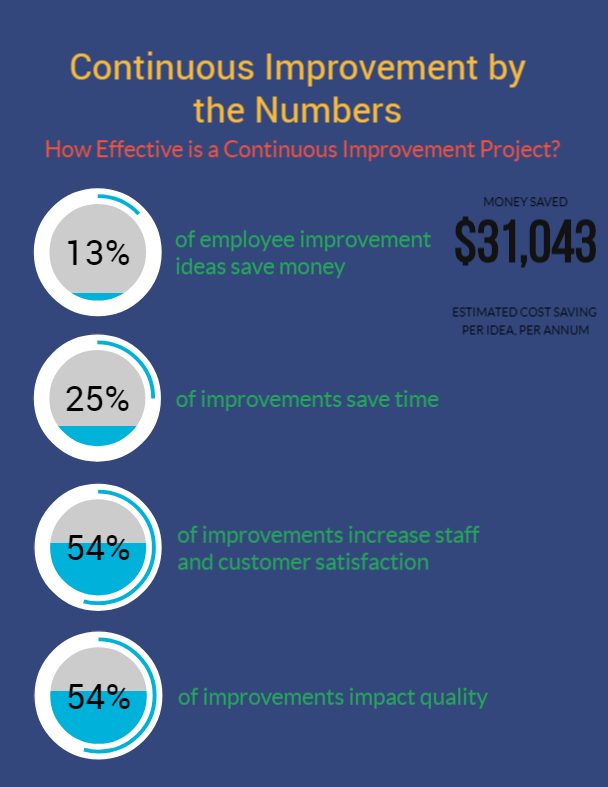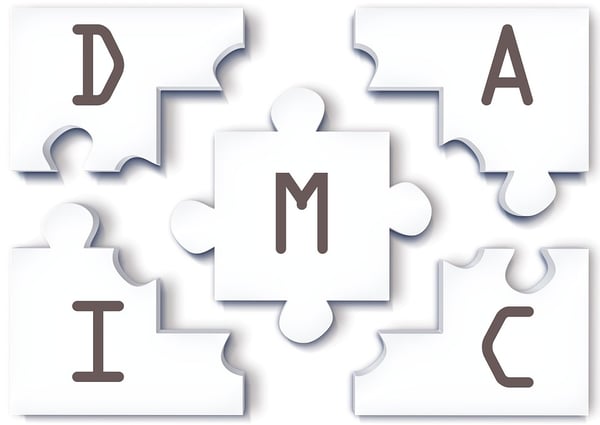Continuous Improvement is an ongoing, long-term approach to improving processes, products and services. It is also called Continual Improvement or CI, and is one of those terms which we often think we fully understand, but can actually mean many different things to many different people.
This article gives a simple guide to Continuous Improvement by exploring the following:
- The Aim of Continuous Improvement
- 5 Crucial Aspects of an Improvement Plan
- 3 Continuous Improvement Tools that are Easy to Understand
- The First Steps Toward Continuous Business Improvement
- Some Practical Help
If you don't fancy reading the whole thing, feel free to click straight to the section you are most interested in.
The Aim of Continuous Improvement
Generally speaking, continuous improvement aims to:
- Increase Efficiency
- Increase Quality
- Reduce Costs
Organisations which implement continuous improvement achieve this by making small, gradual improvements over time.

As the majority of changes are small, there is often less resistance to change, which is ideal for improvement professionals who wish to:
- See results fairly quickly
- Negate resistance to the change initiative
- Create a more agile improvement project
- Get senior management on board with a results led argument for change
- Create a culture of improvement in the business
5 Crucial Aspects of an Improvement Plan
- Improvement is Based on Small Changes - that are each able to be implemented within a fairly short time frame
- It is Clear WHY the Change is Needed - if everyone understands why the current way of working must be updated they will be more invested in the change
- Who the Change Affects is Understood - it is important that everyone affected by the change knows how it will affect them before it comes into place
- Communication Regarding the Change is Crucial to Ongoing Success - the bigger the organisation the harder this becomes - this is where software tools can really help
- The Improvement Must be Analysed - to see whether it really is effective - again where software tools can really help
3 Continuous Improvement Methodologies that are Easy to Understand & Use
1. DMAIC
DMAIC is a methodology made up of 5 phases: Define, Measure, Analyse, Improve and Control.
These 5 phases ensure that any improvement project is able to be analysed with data-driven evidence and repeated.
- Define - Identify the improvement opportunity
- Measure - Capture the process data for documentation
- Analyse - Find the root causes of the process problem (focus on causes, not symptoms)
- Improve - Determine the steps that should be taken to improve the process
- Control - Monitor any change implementation to see if there has been improvement
2. The 5 Whys
The 5 Whys were developed to get to the root cause of a problem; not just identify a problem's symptoms.
These questions are important for exposing flawed processes within an organisation (The 5 Whys also partner well with DMAIC)
The number of Whys can vary but 5 is usually the right number to get to the root of the problem.
Here is an example...
The customer is unhappy
Why is the customer unhappy? (1)
The customer is unhappy because no one responded to her support request
Why didn’t anyone respond to her support request? (2)
No one responded to her support request because she posted it on Twitter
Why didn’t anyone respond to her tweet? (3)
No one responded to her tweet because Alice is on vacation
Why does Alice’s vacation mean no one responded to the tweet? (4)
Because Alice is the only one who responds to tweets and she doesn’t have a backup
Why doesn’t Alice have a backup? (5)
Because we never thought about it before
3. Value Stream Mapping
Value Stream Mapping is the process of visualising the product pipeline as a series of process connections and measuring the value that those steps brings to the customer.
Value stream maps are used to visualise and identify delays, restraints and excessive inventory within processes. There are three groups within the value stream...
- Value Adding – a customer is willing to accept this step as an acceptable cost to them
- Non-value Adding – the customer feels it unfair to assign these costs to them
- Necessary Non-value Adding – costs to the customer are necessary but the customer may still feel unhappy to pay

The First Steps Toward Continuous Business Improvement
1. Set Smart Goals
Improvement starts with objective setting. Your objective can be anything, but should be broken down into SMART goals.SMART goals are:
- Specific
- Measurable
- Achievable
- Relevant
- Timebound
For more information on SMART goals please read this article, but I find it most helpful to think of a SMART goal as being the full address of where I want to get to next. This may not be my ultimate objective, but it’s where I want to arrive first. So, for example if my objective is to improve my customer service to make my customers happier, just leaving it at that gives me a very vague place to head to – which means I will really struggle to plan a route to get there.
If, however, I set my first goal as reducing closing 90% of the support tickets in 48 hours, within 3 months – then I have the a very clear place to head to, and now all I need to do is identify improvement opportunities in the current customer service process - and implement them. (And once I do, I set my next smart goal and so on…)
2. Document your Processes
When embarking on a continuous improvement project it is important to have clarity on the current state (the way you do things today), clarity on exactly what you are changing (the proposed future state) and clarity on the delivered benefits.
Your continuous improvement plan will not work if your starting point is not clearly defined. It is very difficult to make improvement changes to a process if you do not understand the steps currently involved in that process, which is why one of the most important first steps in a Continuous Improvement Plan is understanding exactly how things are done currently. The easiest and most efficient way to do this Process Mapping - this can be done with Process Mapping software or with paper and post-it-notes.
When you understand how a process is done, you can see any inefficiencies in the process, this has multiple benefits including:
- Small changes you can make to improve the process become obvious
- Making it clear to everyone why changes need to be made
- Understanding who is involved in the process - so who will be affected by any changes made
Once you have understood where the inefficiencies lie in your process you can begin to improve them, of course as you start you won’t know exactly what you need to do to achieve your smart goal – otherwise you would just do it. But you do know that achieving improvement is about making lots of small changes, starting with obvious inefficiencies and measuring the results to see if they are taking you towards your goal. If they are, you do more of them and if they aren’t, you stop doing them!
Once you have made these changes, you can add them to your Process Map, so everyone knows exactly what is being changed and how the change will affect them. This ensures that everyone is clear about what is being changed and what benefits the change should bring about.
By creating Process Maps for all your processes and finding ways to improve each process, documenting while you go, you can:
- Improve based on small changes
- Make it clear why the change is necessary
- Understand exactly who the change affects
- Easily communicate what the change is
- Analyse whether each change has improved the process or not
Some Practical Help
Triaster has been working in the Continuous Improvement space for many years and based on experience and analysis of how the most successful organisations do it, have developed Process Mapping software which enables all of the above, to best support Continuous Improvement.
We offer a free plan for getting started:
Related Articles:
How do I create a culture of Continuous Improvement?
DMAIC Process vs Cycle: Why Process Wins Every Time
How to Implement Value Stream Mapping Software in a BPM System
Related White Papers:
The Complete Guide to Continuous Improvement in Business
This is an updated and refreshed edition of an article originally written in 2018.
Written by Emma Harris
Emma was Operations Director for Triaster for nearly 20 years, during which time as well as learning and perfecting her BPM and process improvement skills, she honed her inbound marketing expertise. She now runs D2e - Designed to engage - which designs and develops bespoke, engaging, HubSpot CMS websites, that help your entire company to grow and scale. She is delighted to still be delivering Triaster's marketing, whilst also helping other companies turn their websites into their hardest working asset.




